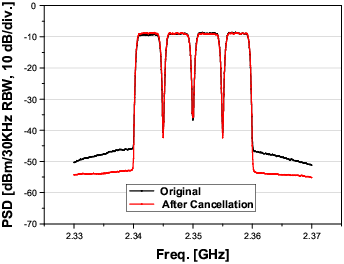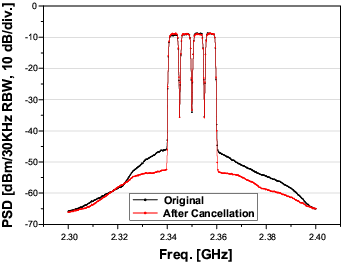1.
Feedforward Power Amplifier with a New Adaptive Control Method
Feedforward amplifier is one of the most popular linearization
techniques for base station power amplifiers. The feedforward amplifiers
ideally have the capability of perfect cancellation of unwanted in-band IM
products. However, a high level cancellation is not easily achieved due to
premature saturation of an error amplifier, as well as the gain and phase
mismatches. The distortion generated by the error amplifier reduces the error
cancellation capability of the feedforward amplifier. The perfect signal
cancellation in the 1st loop of the feedforward amplifier is not an optimum for
minimizing the output error level since the error amplifier with an imperfectly
cancelled input generates less distortion signals and the linearity of the
amplifier can be improved.

Figure 1
Fig. 1 shows the input and output signals of
the error amplifier for a perfect signal cancellation and an optimum signal
cancellation cases. The pure error signal after a perfect signal
cancellation has a high peak-to-average ratio (around 20dB) and the error
amplifier with the input generates significant distortions even at a very low
average output power. This distortion terms degrade the cancellation
performance of the feedforward amplifier. However, the error amplifier with an
imperfectly cancelled input signal generates less harmonic distortions due to
cancellation of the distortion by the cross modulation term of the error and residual
main signals. The cancellation level can be optimized by the new adaptive
control method. Therefore, we adopt a new merged control method to adjust the
signal cancellation level for the best linearity of the feedforward amplifier.
Fig. 2 shows a feedforward system to apply the
new adaptation Method. The new adaptive method detects error term of the final
output and then adjusts the main signal cancellation level (1st loop) and the
error signal cancellation level (2nd loop), simultaneously. By this operation,
the error signal becomes imperfect cancellation signal and the distortion
generated by the error amplifier is reduced.

Figure 2

Figure 3
To
validate the proposed adaptive control scheme, a 2.14 GHz adaptive feedforward
amplifier for down-link 16-channel WCDMA signal has been implemented as shown
at fig. 2. Fig. 3 shows signal cancellation levels of the error signals and
final outputs with two-carrier WCDMA signal.
The signal cancellation level of the new case is
20 dB, which is 8 dB lower than that of the conventional case (see fig. 3(a)). The
IMSR at 5MHz offset of the new method is about -50 dBc, but the conventional
case is -44 dBc (see fig. 3(b)). Therefore linearity of the new case is improved
by 7 dB.
2.
Predistortion Power Amplifier for Base-Station using an Feedforward Loop Linearizer
For linear amplification of the error signal in the feedforward system, the
peak envelope power(PEP) of the error amplifier should be high because the harmonics
from the error amplifier reduce the cancellation level [10]. Besides, the delay
compensation line and coupler losses are burdens of the amplifier in terms of
an average output power and efficiency of the system. Due to the reasons, the
feedforward amplifier has a low efficiency contrary to the high linearity performance.
Therefore, the feedforward loop has been used for the predistortion
signal generator. Since the feedforward loop is placed in front of the main
amplifier, the PEP and gain of the error amplifier is reduced significantly
compared to the conventional feedforward system. Also the delay line and coupler
losses are not significant factors affecting the amplifier performance. The
main requirement of the new amplifier is the same IM amplitude and phase characteristics
between the predistorter and main amplifier.

Fig. 1. The proposed linearization
circuit using feedforward predistortion(FFP).
Fig. 1 shows the proposed
amplifier diagram. Five identical Doherty amplifiers, one for the error generation
amplifier(EGA) and four for the main amplifier, are built using 90W PEP LDMOSFETs. Therefore,
the main amplifier can handle a 720W PEP and has been tested at an average output
power of 47.8 dBm, 10.8 dB backed-off from the peak power. The error amplifier
stage with the gain of 51 dB has been configured in the second loop. The
vector modulator for the amplitude and phase controls is fabricated with the
series connection of a reflection type attenuator and phase shifter using 3
dB hybrid couplers, PIN diodes and varactor diodes. Both the first and second
loop delays have been compensated using coaxial cables of 9.9 ns and 16 ns,
respectively.
For
the verification, the experiments have been conducted using a forward-link WCDMA
4-carrier signal at 2:35 GHz. Fig. 2(a) and (b) show the power spectral density
of the output at an average output power of 47.8 dBm with the spans of 40 MHz
and 100 MHz. The ACLRs at 5 MHz and 10 MHz offsets are -46.3 dBc and -48.7 dBc,
respectively, enhanced by about 7.1 dB and 5.4 dB, respectively, by the cancellation.
This cancellation is a little lower than that of the single DPA case due to
the nonuniform DPAs, power divider and combiner, which can be solved in the
well controlled manufacturing environment. As shown in Fig. 2(b), the power
spectral density of the canceled output has a symmetrical shape, illustrating
the strong immunity to the serious memory effect. The total efficiency of the
amplifier with the proposed topology is about 12.7 %, which is enhanced siginificantly
compared to the general feedforward type LPA for basestation.


Fig. 2. The power spectral density of the amplifier with four Doherty main
amplifier at average output power of 47.8 dBm : 40 MHz and 100 MHz
span.
[1]
Y.Y Woo, Y. Yang, J. Yi, J. Nam, J.H. Cha and
B. Kim, "Feedforward Amplifier for WCDMA Base Stations with a New Adaptive
Control Method," IEEE MTT-S Int. Microwave Symp. Dig., Vol. 2, pp.
769-772, June 2002.
[2]
I. Kim, J. Cha, S. Hong, Y. Y. Woo,
J. Kim, and B. Kim, "Predistortion power amplifier
for base-station using an feedforward loop linearizer,"
in Proc. IEEE European Microw. Conf., Manchester,
UK, Sep. 2006, pp. 141-144.
[3] Y. Y. Woo, Y. Yang, J.
Yi, J. Nam, J. Cha, and B. Kim, "A new adaptive feedforward amplifier for
WCDMA base stations using imperfect signal cancellation," Microwave
J., vol. 46, no. 4, pp. 22-44, Apr. 2003.
[4] Y. Yang, Y.
Y. Woo, and B. Kim, "Optimization for error-canceling loop of the
feedforward amplifier using a new system-level mathematical model," IEEE Trans. Microw. Theory Tech., vol.
51, no. 2, pp. 475-482, Feb. 2003.
[5] B. Kim, Y. Y. Woo, J. Yi, J. Nam, and
J. Cha, ¡°A new adaptive feedforward amplifier using imperfect
signal cancellation,¡± 3rd International Conference on Microwave and Millimeter
Wave Technology (ICMMT2002), Beijing, China, Aug., 2002.
[6] Y. Y. Woo, Y. Yang, J. Yi, J. Nam, J. Cha, and B. Kim, "Feedforward
amplifier for WCDMA base stations with a new adaptive control method," IEEE
MTT-S Int. Microwave Sympo., Seattle, Vol. 2
, pp.769 -772, June, 2002.





